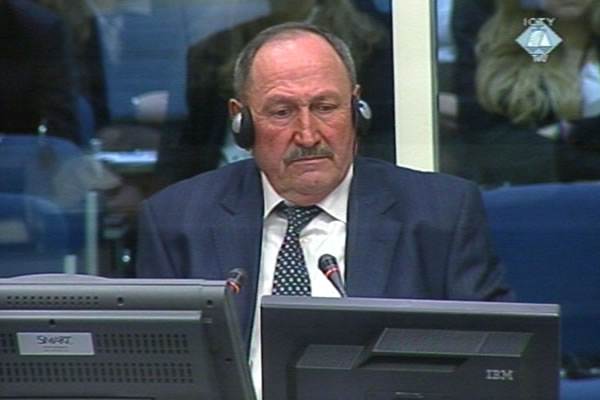Home
RESPONSIBILITY FOR MARKALE MASSACRE CONTESTED AGAIN
Two defense witnesses called by Radovan Karadzic deny that the shell that hit the Markale market on 5 February 1994 was fired from Serb positions. Ukrainian lieutenant colonel Moroz says he had been told by a Russian man that the explosion had been caused by a planted special device. A former VRS officer contends that on that day Serbs did not violate the ceasefire
 Milorad Dzida, defence witness of Radovan Karadzic
Milorad Dzida, defence witness of Radovan Karadzic Following in the footsteps of the previous four witnesses called by Radovan Karadzic's defense, the two witnesses who testified today: Ukrainian lieutenant colonel Sergey Moroz and VRS major Milorad Dzida, denied that the mortar shell that caused the massacre at the Sarajevo Markale market had been fired from Serb positions.
In October 1993, Moroz was appointed commander of the engineering sector in the UNPROFOR Ukrainian Battalion and remained in that post for a year. Moroz already testified about his findings about the market shelling at the trial of Stanislav Galic. A month after the massacre, Russian officer Rumyantsev told him that the explosion wasn't caused by a mortar shell fired from Serb positions but that a 'special explosive device was planted at the market', Moroz claimed. Rumyantsev was involved in one of the UN investigations.
The prosecutor showed Moroz a report written by the UNPROFOR investigation team signed by Rumyantsev. The report states that the explosion was caused by a 120-mm mortar shell. The report notes that the shell exploded immediately above the ground and establishes the shell's trajectory. The prosecutor argued it was difficult to understand why Rumyantsev would tell the witness something that contradicts what he wrote in the report. The witness refused to budge. Rumyantsev died in 2001 and the Trial Chamber will not be able to verify Moroz's allegations.
The second witness to take the stand today, Milorad Dzida, served as deputy commander of the battalion that controlled mortar positions on Mrkovici and Debelo Brdo at the time of the Markale massacre. The prosecution alleges that the fatal shell was fired from those positions. In his statement, Dzida claimed that three mortars were deployed at each position. They were used only to respond to the attacks and never to target civilians. As Dzida claimed, they observed every ceasefire agreement, while Muslims constantly violated them. A joint commission made up of the UNPROFOR soldiers and the VRS visited his positions the morning after the Markale market incident and concluded that fire had not been opened from there, the witness said.
In the cross-examination, Dzida made a correction, saying there were eight, not six mortars at the two positions. The prosecution showed the witness a report from a meeting between VRS officer Radoslav Cvetkovic and UNPROFOR representatives on 13 February 1994. At the meeting, Cvetkovic claimed that he 'learned from talking to people’ that shells were not fired from Serb positions. At the same meeting, Cvetkovic wondered why the UN 'has so much interest in a single shell when last year we fired about 40,000 of them'. Cvetkovic invited UNPROFOR staff to visit any places they suspected the shell might have been fired from. When the prosecutor told Dzida it seemed strange that Cvetkovic wasn’t aware about the purported visit to VRS positions, which according to Dzida occurred the day after the attack, Dzida replied that Cvetkovic 'should have been aware of it'.
The prosecutor contested the witness's claims that UNPROFOR checked his positions once every week or two weeks at most. A report UN observers wrote in February 1994 states that they had not been allowed access to VRS mortar positions for four months. Dzida remained adamant that in January 1994 he personally led the observers to visit Mrkovici and Debelo Brdo.
Linked Reports
- Case : Karadzic
- 2012-10-31 CONTESTING THE RESULTS OF THE FIRST MARKALE MASSACRE INVESIGATION
- 2012-10-30 DENYING THE FIRST MARKALE SHELLING
- 2012-10-24 PAPOULIAS WILL NOT TESTIFY AT KARADZIC TRIAL
- 2012-11-05 MOMIR CLAIMS HE’S ‘MOCALO’ NOT ‘MOMO’
- 2012-11-06 ‘JOINT COMMISSION’: DID IT REALLY EXIST?
- 2012-11-07 PEACE INITIATIVES AND ATTACKS IN RAJLOVAC
